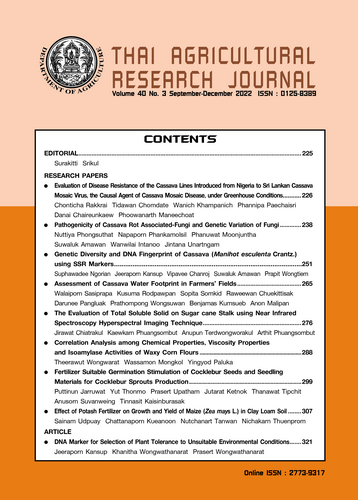The Evaluation of Total Soluble Solid on Sugar cane Stalk using Near Infrared Spectroscopy Hyperspectral Imaging Technique
DOI:
https://doi.org/10.14456/thaidoa-agres.2022.23Keywords:
the total soluble solid, sugarcane stalk, near infrared spectroscopy hyperspectral imaging techniqueAbstract
Near-infrared hyperspectral imaging technique (NIR-HSI) is an inspection method that is applied to evaluate the quality of agricultural materials without the need to destroy the sample. It is also accurate and fast. In this study, near infrared hyperspectral imaging technique was performed to develop the total soluble solid (TSS) predicting model from Khon Kaen 3 variety sugarcane stalk aged 8-11 months. The obtained data were in the form of three-dimensional spectral data (Hypercube) within wavelength of 900-1700 nm which were derived from reflectance measurement. TSS data from the reference method were used to create a calibration model with Partial Least Squares Regression (PLSR). The sugarcane samples were measured for absorbance before and after stalk’s surface wax removal. It was found that the predicting model from samples without wax had the best predictive results, providing coefficient of determination (R2) of 0.87, standard error of prediction (SEP) of 0.97 °Brix, and RPD of 2.77. This indicated that the predictive equations were effective for use in quality evaluation. The model was thereafter applied to the absorbance data of each pixel in the hypercube data, and the distribution of TSS values on the sugarcane stalk surface was obtained. The distribution map was able to visualise only for the upper half of the cane sample, which was the limitation of this method when measuring a cylindrical object. This still requires further development of appropriate measurements. However, the results showed the feasibility of using NIR-HSI to evaluate the total soluble solid (TSS), which can be used instead of conventional methods in laboratories. It could also be used for visually detecting the right maturity of the sugarcane in the field.
References
คณะกรรมการอ้อยและน้ำตาลทราย. 2560. ประกาศคณะกรรมการอ้อยและน้ำตาลทราย พ.ศ. 2560. เรื่อง กำหนดปริมาณ มาตรฐานในการผลิตน้ำตาลทรายของโรงงาน. ราชกิจจาณุเบกษา เล่มที่ 134 ตอนพิเศษ 254 ง หน้า 36. แหล่งข้อมูล: www.ratchakitch.soc.go.th. สืบค้น: 6 มิถุนายน 2565.
Aparatana, K., K. Saengprachatanarug, Y. Izumikawa, S. Nakamura and E. Taira. 2020. Development of sugarcane and trash identification system in sugar production using hyperspectral imaging. J. Near Infrared Spectros. 28(3), 133-139.
Berding, N., G. A. Brotherton, D.G. Le Brocq and J.C. Skinner. 1991. Near infrared reflectance spectroscopy for analysis of sugarcane from clonal evaluation trials: I. Fibrated cane. Crop Sci. 31(4), 1017-1023.
Caporaso, N., M.B. Whitworth and I.D. Fisk . 2018. Protein content prediction in single wheat kernels using hyperspectral imaging. Food Chemistry. 240, 32-42.
James, C.S. 1995. Analytical Chemistry of Foods. Blackie Academic & Professional, London, 178 p.
Kirasak, K., T. Sansayawichai, W. Ponragdee and A. Thipyawat 2015. Determination of commercial cane sugar (ccs) using near infrared spectroscopy. Thai Agricultural Research Journal. 33(2), 159–168.
Manley, M. 2014. Near-infrared spectroscopy and hyperspectral imaging: non-destructive analysis of biological materials. Chem. Soc. Rev. 43(24), 8200-8214.
Maraphum, K., S. Chuan-Udom, K. Saengprachatanarug, S. Wongpichet, J. Posom, A. Phuphaphud and E. Taira. 2018. Effect of waxy material and measurement position of a sugarcane stalk on the rapid determination of Pol value using a portable near infrared instrument. J.Near Infrared Spectros. 26(5), 287-296.
Maraphum, K., K. Saengprachatanarug, K. Aparatana, Y. Izumikawa and E. Taira. 2020. Spatial mapping of Brix and moisture content in sugarcane stalk using hyperspectral imaging. J. Near Infrared Spectros. 28(4), 167-174.
Martinsen, P. and P. Schaare. 1998. Measuring soluble solids distribution in kiwifruit using near-infrared imaging spectroscopy. Postharvest Biol.Technol. 14(3), 271-281.
Nawi, N.M., M.R. Kamal, G. Chen and T. Jensen. 2014. Prediction of Sugarcane Quality Parameters Using Visibleshortwave Near Infrared Spectroradiometer. Agric. Agric. Sci. Procedia 2. 136–143.
Osborne, B. G., T. Fearn. and P. H. Hindle. 1993. Practical NIR spectroscopy with applications in food and beverage analysis. Harlow, Longman Scientific and Technical.
Rungpichayapichet, P., Nagle, M., Yuwanbun, P., Khuwijitjaru, P., Mahayothee, B. and Müller, J. (2017). Prediction mapping of physicochemical properties in mango by hyperspectral imaging. Biosyst. Eng, 159, 109-120.
Sanseechan, P., L. Panduangnate, K. Saengprachatanarug, S. Wongpichet, E.Taira and J. Posom, J. 2018. A portable near infrared spectrometer as a non-destructive tool for rapid screening of solid density stalk in a sugarcane breeding program. Sens. Bio-Sens. Res. 20, 34-40.
Singh, C. B., Jayas, D. S., Paliwal, J., White and N. D. G. 2012. Fungal damage detection in wheat using short-wave near-infrared hyperspectral and digital colour imaging. International Journal of Food Properties. 15(1), 11-24.
Taira, E., Ueno, M. and Kawamitsu, Y. 2010. Automated quality evaluation system for net and gross sugarcane samples using near infrared spectroscopy. J.Near Infrared Spectros, 18(3):209-215.
Tewari, J., Mehrotra, R. and Irudayaraj, J. 2003. Direct near infrared analysis of sugar cane clear juice using a fibre-optic transmittance probe. J. Near Infrared Spectros. 11(5), 351-356.
Williams, P. 2004. Near-infrared technology: getting the best out of light: a short course in the practical implementation of near-infrared spectroscopy for the user. PDK Projects, Incorporated.
Zhu, Y. J., Komor, E. and Moore, P. H. 1997. Sucrose accumulation in the sugarcane stem is regulated by the difference between the activities of soluble acid invertase and sucrose phosphate synthase. Plant Physiol. 115(2), 609-616.
Downloads
Published
How to Cite
Issue
Section
License
Copyright (c) 2022 Thai Agricultural Research Journal

This work is licensed under a Creative Commons Attribution-NonCommercial-NoDerivatives 4.0 International License.
Thai Agricultural Research Journal



